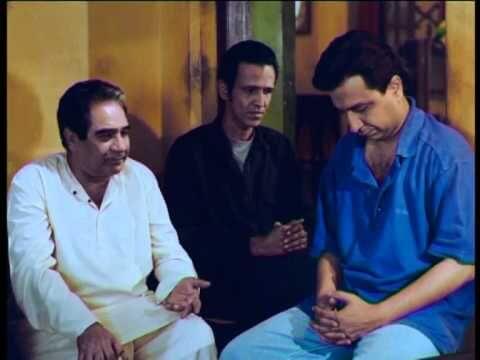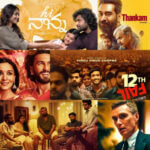Curfew, fear, tension, chanting of Ram and Allah from either side – December 1992 – the time was cruel which exuded the smell of hatred and discrimination everywhere. Communal tension was at all-time high and hope was quite bleak. A sense of chaos prevailed in the atmosphere.
There are less to no films in Indian cinema based on the Babri Masjid demolition on 6th December, 1992. If you put a little strain on your brain, you will come up with a handful of films dealing with the said issue (example: Bombay (1995)). It is ironic because cinema is seen as a medium which depicts the reality of our society. It is seen as a tool which is used for social commentary. Even in the 40s and the 50s, Hindi cinema has been largely socialist in nature – acting as the voice of the voiceless and promoting messages of equality and liberty through added dose of entertainment. Films like Do Bigha Zamin (1953), Pyaasa (1957), Mother India (1957) and Naya Daur (1957) are some classic examples of this genre. But over the years, the number of such films have reduced and now there are only a few filmmakers left who take the risk of making films that make bold and raw statements about society and system.
Filmmaker Saeed Akhtar Mirza is one of the top filmmakers whose films have not shied away from touching the hardcore realities of our lives without any compromise. Naseem (1995) is one such film which highlights the social disturbance of the nation and the gradual mental instability caused by it in a middle class Muslim family in Bombay (now Mumbai) during the period of June–December, 1992. The episodic structure of the film brings out all the events of Naseem’s life in a chronological order which helps the viewers in a better understanding of the trauma faced by the Muslim community at the time, especially for those who were either non-Muslim or non-existent at that time. Events leading to the demolition of Babri Masjid on 6th December, 1992 have been sensitively depicted by Mirza in a way that one can’t help but sympathize with Naseem’s family. The gracious presence of the renowned Urdu poet Kaifi Azmi in the film induces some warmth to the otherwise disturbing piece of cinema. He is engrossed in poetry and reminisces his young days of pre-independent India.
Naseem begins with a shot showing the protagonist sitting in front of a mirror, brushing her hair, oblivious to the sound of the chants and slogans coming from the television. Her brother and mother are also visible in the mirror, curiously looking at all the disturbing events shown on the television. The juxtaposition of the two moods in one frame highlights the unseen tussle between the calm and the chaos. Naseem then gets up smilingly and enters her grandfather’s room. The television’s sound dissolves and a welcoming silence spreads. Naseem sits by her grandfather and asks him the meaning of her name. He tells her it means the morning breeze, which is beautiful just like her granddaughter. Naseem smiles, and in that close-up shot, Mirza captures that soaring innocence on her face which makes us forget about the tension that we witnessed a while ago.
Saeed Mirza takes us into Naseem’s life gradually and through her behaviour we come to know of her nature. She gets mesmerised by the smoke oozing from concentrated acid during her practicals. Even after she is scolded by her teacher, she asks her friend Zoya whether the smoke looked lovely or not. After dispersal, Naseem asks her friend if she should whistle. After getting nods from everyone, she does and then starts teaching whistling to other girls. Her carefree and mischievous nature appears to be in stark contrast with the very first image the viewers had of her in their minds – shy, innocent, calm and composed. Later, when she reaches home, she offers to help her mother (Surekha Sikri) in washing clothes. But there too, just like in the science lab, she starts playing with the foam. Naseem is then asked to change her clothes. The scene then cuts to the grandfather’s room where he is laying on his bed after taking medicines. Naseem is sitting on a low armchair with a plate full of onions. She is busy cutting them when her grandfather proposes to tell her a ‘qissa’ (incident). Naseem proposes to listen to it after she’s done with the vegetables. Hearing this, her grandfather recites a couplet:
Masroof hai khudai, masroof hai zamaana,Fursat ke chand lamhe tumko milein to aana
A tonal shift occurs in the scene when Naseem’s father Sajjad (Kulbhushan Kharbanda) comes home, disturbed by a show cause notice that he has been given. This changes the mood of the scene for a while until Naseem’s grandfather breaks the silence by sourcing a tale of his younger days and the film goes into the flashback as he recollects his memory.
Akhtar’s stories are his light experiences of pre-independent India that he reminisces. He loves telling them over and over again, especially to Naseem. These stories are also suggestive of the good memories that Akhtar has of his younger days. Contradicting his memories are the harsh realities of the present, the time in which his family lives. The rising hatred and the “othering” of the minorities is in its full form. The fire of discrimination slowly spreads in every state and there is nothing that can be done. Akhtar’s stories offer us hope while the repetitive news of riots and violence being aired on the television seems to put an end to it. Silent stares and dreaded sights of violence showcase the fear and helplessness of Naseem’s family. Naseem presents both good and bad times together and offers a discourse on one of the sensitive issues of the nation. Both these elements come face-to-face with each other. In one of the scenes, the news of the horrendous violence on television prompts Sajjad to ask – Where will they go leaving their own home? Naseem’s grandfather, on hearing the same, asks everyone to shut down the television, further justifying so for she has her exams the next day. It is then that her elder brother Mushtaq (Salim Shah) bursts out in frustration and asks him how exams can be more important than the news of the inflicting violence on the Muslim community. He further lashes out at him for only telling stories even in such a situation. Mushtaq expresses his anger as he is unable to understand why his grandfather is reluctant in admitting that the era of narrating stories is long gone.
This is not Mushtaq bursting out. This is the voice of the youth that does not see stories and poetry as solutions to oppression and hatred. In dark times like these, poetry and stories seem weak and incapable of even standing against the injustice perpetrated by lakhs of people, Mushtaq feels. He later steps out of the house, in anger.
Naseem has so many contrasting moments. There are some disturbing images like the one where a man proudly waves the saffron flag as a huge crowd marches towards Ayodhya. Another scene is of the dead body of a Hindu woman whom Naseem used to greet on her way to school. It is told that her husband burnt her alive as she couldn’t bear him a son. Mirza uses the poetry and the tales that suggest nostalgia in order to reduce the looming tension and rising hatred of the right wing forces. It can also be said that Akhtar is a tool, to express the filmmaker’s own ideology and belief that goodness prevails. The idea behind narrating such stories of pre-independent India might also be to remind the hatemongers how our past was beautified with unity against one common enemy.

The clash between the ideologies: Kulbhushan Kharbanda, Kay Kay Menon and Salim Shah in Naseem
But there are some who think that revenge is the only solution, like Mushtaq’s friend Zafar (Kay Kay Menon), who is a religious fundamentalist. His stern face and serious look often suggests a threatening aura. During the Eid party, when the grandfather forgets a couplet of Mir Taqi Mir, Zafar recites it. Following which, a conversation ensues between the two where at one point he suggests that only Faiz’s couplet should be recited in such troublesome times which he further recites:
Jaza saza sab yahin pe hogi, yahin pe azaab-o-sawaab hoga
Yahin se uthega shor-e-mehshar, yahin pe roz-e-hisaab hoga
Zafar takes a different route with this couplet. He emphasizes on his desire for a full-fledged revenge. He thinks that poetry’s context changes with time. Clearly, he wants a change now. He wants the oppressed Muslims to rise up and stand against the perpetrators, while Akhtar, on the other hand, tries to tell him that he is wrong. Here again, we see a clash of moral values of two people – one being young, enthusiastic and full of anger; the other being old, calm, composed and always hinting at peace.
When the dreaded day arrives, the grandfather leaves the world. Mirza uses Akhtar’s death as a metaphor for dying humanity and peace. Naseem is sad and teary-eyed, but you never see her crying profusely. For her, the memories of her grandfather are still fresh which keeps her going with that infectious smile on her face. She has them, fond ones, and we see a glimpse of it in the end where she is sitting with him on the terrace, looking towards the open field and asking him why the sky is blue. The grandfather tells her that he didn’t like it yellow so he painted it blue which makes her laugh and she calls him unscientific. The man explains that his intention was to make her smile and for him, her smile and laughter are more important than the colour of the sky. In the final shot, Naseem wears a slight smile on her face as if giving a tribute to her grandfather by continuing to be how he wanted her to be even in the moments of utter despair.
Probably, Naseem is not just about one of the cruelest tragedies imposed on mankind, but also about the hope to live on in the darkest of times. Naseem does not only mirror the chaos in the Muslim community in 1992 but also talks about the importance of peace and resilience. Saeed Akhtar Mirza’s final film is still very much relevant and relatable to many which can sadly not be termed as a compliment.















Add Comment